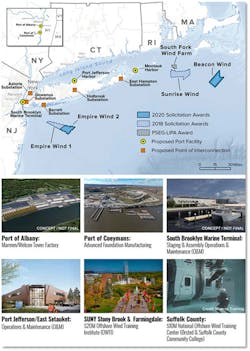While some U.S. construction economists are hedging their 2023 forecasts a bit because of concerns about a potential recession, they tend to agree the construction of monstrous semiconductor plants will be among the largest projects to break ground next year. Electrical construction professionals will also be busy with the design and construction of utility-scale solar and wind farms that often include a large energy storage component.
Tax breaks and other financial incentives from federal programs like the Infrastructure Investment and Jobs Act, CHIPS and Science Act, and the Inflation Reduction Act will fuel many of these projects, and at least one electrical manufacturer told EC&M magazine that this influx of federal funding will be a “once-in-a-lifetime opportunity” for the electrical industry. Let’s take a look at some of these massive projects.
SEMICONDUCTOR PLANTS
If all eight of the chip factories are built, total investment in the 1,000-acre site could hit $100 billion.
Megaprojects in the semiconductor market will also account for a huge share of these construction opportunities because Intel, Samsung, Taiwan Semiconductor and Texas Instruments plan to spend $105 billion on new chip manufacturing plants. The biggest of them all is the $30-billion manufacturing campus Texas Instruments says it will build in Sherman, TX. Intel made headlines this year when it announced that it would be spending $20 billion on greenfield semiconductor plants in Licking County, OH. The company is also spending $20 billion on an existing facility in Chandler, AZ.
Because of geopolitical concerns about relying so much on semiconductor plants in China and other countries and how semiconductor shortages continue to cause lengthy production delays across the U.S. industrial economy, Congress is working on the CHIPS for America Act as part of the 2022 Defense Authorization Act (NDAA)). This legislation would offer semiconductor manufacturers billions of dollars in financial incentives if they build semiconductor plants or R&D facilities in the United States. If the legislation passes, as expected, it will support a new wave of construction in the semiconductor industries.
RENEWABLES
New York’s five offshore wind projects, proposed port facilities, key infrastructure investments, and proposed points of interconnection. Photo credit: www.nyserda.ny.gov
While the construction of utility-scale wind and solar farms has been strong over the past few years, a whole new segment of the renewables market that will soon start pumping billions of dollars into the electrical market is offshore wind. The recent auction for wind farm development rights covering more than 480,000 acres off the coasts of New Jersey and New York is the latest indication that U.S. offshore wind farms will be ramping up in the next few years.
Some wire and cable manufacturers will supply the high-voltage undersea cables linking the wind turbines and offshore substations several miles to the onshore electric utility network. But the big play for many electrical manufacturers, distributors, contractors and engineering firms will be the development of onshore electrical infrastructure for the staging areas at U.S. ports where crews will ferry equipment out to the wind farms; facilities to build or assemble foundations and towers for the turbines; training facilities for workers in the wind industry; and shipyards building the CTVs (crew transfer vehicles) that will take workers to the wind farms, which will typically be at least 9 to 30 miles offshore.
While some small-scale wind farms are operating or are being built off the coasts of New England and Virginia, the bulk of the development activity is being planned off the coasts of New Jersey and New York. According to a press release from the Bureau of Ocean Energy Management (BOEM), the areas covered by the New York Bight leases in the Feb. 23 auction could eventually provide 5.6 GW (gigawatts) to 7 GW of offshore wind energy — enough to power nearly 2 million homes. According to a report at www.offshorewind.biz, this auction attracted 25 bidders, including big names in the offshore wind business like BP, Equinor and Shell.
In 1Q 2022, there was a steady flow of news about development activity in this niche with a direct impact on the electrical wholesaling industry. For example, Southwire announced it would manufacture 32 miles of cable for the Vineyard Wind project off Cape Cod, and the New Jersey Wind Port, a $300-million to $400-million project south of Philadelphia on Delaware Bay, is moving quickly through the planning process. It will service the 1,100-MW offshore wind farm that will be built by Ørsted off of Atlantic City, NJ.
While it will be several years before developers start building any wind farms off of California’s coast, the federal government’s Bureau of Ocean Energy Management (BOEM) will be holding a lease sale in December 2022 for approximately 373,268 offshore acres in the Pacific Ocean. BOEM says that acreage has the potential to produce more than 4.5 GW of offshore wind energy — enough to power more than 1.5 million homes.
ENERGY STORAGE
Tesla recently installed 91 Megapack batteries at a facility in Angleton, TX, which have an estimated total capacity of 100 MW. Some analysts say the company’s energy storage business unit could one day be bigger than its EV auto unit. Photo credit: Tesla
The electricity that some of the mammoth wind farms and solar farms being built will be stored in utility-scale energy storage battery facilities. Florida Power & Light (FP&L) recently completed one of these facilities in Dec. 2021, its 409 MW Manatee Energy Storage Center. FP&L says the facility has enough capacity to power approximately 329,000 homes for more than two hours.
According to an FP&L press release, the energy storage facility gets power from the adjacent 74.5 MW Manatee Solar Energy Center. “The Manatee Energy Storage Center consists of 132 energy storage containers, each of which holds roughly 400 battery modules, on 40 acres in Parrish, FL,” according to the release. “The Manatee Energy Storage Center is the world’s largest battery when measured by generating output and the world’s largest solar-powered battery when measured by both total output and capacity per hour.”
Tesla is another big player in energy storage, through both its Powerwall batteries for residential applications that store power from rooftop PV systems and its Megapack batteries. The company recently installed 91 Megapack batteries at a facility in Angleton, TX, which have an estimated total capacity of 100 MW.
With the uncertain 2023 economic outlook, supply chain snafus and potential worker shortages, don’t be surprised if some of the mega projects mentioned in this article or discussed in the Mega Project Mania article (https://www.ecmweb.com/construction/whitepaper/21239608/mega-project-mania) published earlier this year are delayed or postponed indefinitely. But there are enough of them already underway or close enough to groundbreaking that electrical contractors and other electrical professionals should start seeing a surge in new revenue opportunities in the construction of new semiconductor plants, utility-scale solar or wind farms and battery storage facilities.
ABB provides customers across various industries with end-to-end products and solutions that are cleaner, smarter, and more efficient without compromising safety or reliability. ABB is leading the future of electrification with advanced technologies and equipment to protect and control the distribution of electricity throughout a facility’s infrastructure. Explore ABB’s comprehensive electrical offering today.
Sponsored By:
About the Author
Jim Lucy
Editor-in-Chief, Electrical Wholesaling & Electrical Marketing
Over the past 40-plus years, hundreds of Jim’s articles have been published in Electrical Wholesaling, Electrical Marketing newsletter and Electrical Construction & Maintenance magazine on topics such as electric vehicles, solar and wind development, energy-efficient lighting and local market economics. In addition to his published work, Jim regularly gives presentations on these topics to C-suite executives, industry groups and investment analysts.
He launched a new subscription-based data product for Electrical Marketing that offers electrical sales potential estimates and related market data for more than 300 metropolitan areas. In 1999, he published his first book, “The Electrical Marketer’s Survival Guide” for electrical industry executives looking for an overview of key market trends.
While managing Electrical Wholesaling’s editorial operations, Jim and the publication’s staff won several Jesse H. Neal awards for editorial excellence, the highest honor in the business press, and numerous national and regional awards from the American Society of Business Press Editors. He has a master’s degree in communications and a bachelor’s degree in journalism from Glassboro State College, Glassboro, N.J. (now Rowan University) and studied electrical design at New York University and graphic design at the School for Visual Arts.





